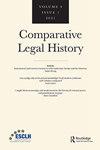苏格兰高地的正义与社会:斯特拉斯佩与格兰特的复辟(约1690–1758)
IF 0.5
Q2 LAW
引用次数: 0
摘要
isprudents。Cino可能特别有用,因为他对法典的不同寻常的评论将正典、民法和习惯法交织在一起。此外,考虑到极具影响力的平民巴托洛斯和巴尔杜斯·德·乌巴尔迪都在14世纪上半叶在比萨教书,对他们的观点进行一些反思可能会提供更多的见解。对ius社区的这种关注将提高该研究已经相当可观的比较层面。公平地说,萨内蒂·多明格斯正确地指出,罗马法律对“教养模式”的影响(如果有的话)很难追踪。她认为,互惠原则可能比任何当代民事判例或实践都更像《旧约》中的塔利奥尼斯法(150–51)。这些结论性意见丝毫无损于这位评论家对这部优秀作品的赞赏。法律历史学家会发现这是一项有价值的研究。对于那些研究中世纪晚期神学和社会的人来说也是如此。Zanetti Domingues对中世纪晚期的社区如何以复杂、相互依存的方式理解暴力、惩罚和精神进行了细致的研究。通过选择锡耶纳,她对经常依赖博洛尼亚和佛罗伦萨证据的解释提出了质疑。如上所述,她的论点同样重要,即锡耶纳的法规并没有反映出惩罚更加严厉的趋势。在锡耶纳等没有得到佛罗伦萨或博洛尼亚密切关注的其他社区的法规中检验这一点将是有益的。未来对中世纪城市刑事司法理论和实践的研究应该密切关注萨内蒂·多明格斯的这项工作。本文章由计算机程序翻译,如有差异,请以英文原文为准。
Justice and Society in the Highlands of Scotland: Strathspey and the Regality of Grant (c.1690–1758)
isprudents. Cino might be particularly useful, given his unusual commentary on the Codex which wove together the canon, civil and customary law. Also, given that the very influential civilians Bartolus and Baldus de Ubaldis both taught in Pisa during the first half of the fourteenth century, some reflection on their views might have provided additional insights. Such attention to the ius commune would have heightened the already considerable comparative dimensions of the study. To be fair, Zanetti Domingues rightly notes that the influence, if any, of Roman law on the ‘penitential model’ is difficult to trace. She contends that the principle of reciprocity likely imitated the Old Testament lex talionis more than any contemporary civilian jurisprudence or practice (150–51). These concluding observations do not detract in the slightest from this reviewer’s appreciation of this excellent work. Legal historians will find this a valuable study. The same holds true for those who examine late medieval theology and society. Zanetti Domingues has provided a nuanced, detailed study of how a late medieval commune understood violence, punishment and spirituality in complex, interdependent ways. By selecting Siena, she has challenged a body of interpretation that has often relied on evidence from Bologna and Florence. No less significant is her argument, noted above, that Siena’s statutes do not reflect the trend towards greater severity in punishment. It would be useful to test this in the statutes from other communes that, like Siena, have not received the close attention given to Florence or Bologna. Future studies of the theory and practice of criminal justice in medieval cities should pay close attention to this work of Zanetti Domingues.
求助全文
通过发布文献求助,成功后即可免费获取论文全文。
去求助
来源期刊
CiteScore
1.70
自引率
0.00%
发文量
20
期刊介绍:
Comparative Legal History is an international and comparative review of law and history. Articles will explore both ''internal'' legal history (doctrinal and disciplinary developments in the law) and ''external'' legal history (legal ideas and institutions in wider contexts). Rooted in the complexity of the various Western legal traditions worldwide, the journal will also investigate other laws and customs from around the globe. Comparisons may be either temporal or geographical and both legal and other law-like normative traditions will be considered. Scholarship on comparative and trans-national historiography, including trans-disciplinary approaches, is particularly welcome.

 求助内容:
求助内容: 应助结果提醒方式:
应助结果提醒方式:


